POJ 3517 And Then There Was One
2011-10-09 23:33
344 查看
原题地址
http://poj.org/problem?id=3517
And Then There Was One
Description
Let’s play a stone removing game.
Initially, n stones are arranged on a circle and numbered 1, …, n clockwise (Figure 1). You are also given two numbers k and m. From this state, remove stones one by one following the rules explained below, until only
one remains. In step 1, remove stone m. In step 2, locate the k-th next stone clockwise from m and remove it. In subsequent steps, start from the slot of the stone removed in the last step, make k hops clockwise on the remaining
stones and remove the one you reach. In other words, skip (k − 1) remaining stones clockwise and remove the next one. Repeat this until only one stone is left and answer its number. For example, the answer for the case n = 8, k =
5, m = 3 is 1, as shown in Figure 1.
Figure 1: An example game
Initial state: Eight stones are arranged on a circle.
Step 1: Stone 3 is removed since m = 3.
Step 2: You start from the slot that was occupied by stone 3. You skip four stones 4, 5, 6 and 7 (since k = 5), and remove the next one, which is 8.
Step 3: You skip stones 1, 2, 4 and 5, and thus remove 6. Note that you only count stones that are still on the circle and ignore those already removed. Stone 3 is ignored in this case.
Steps 4–7: You continue until only one stone is left. Notice that in later steps when only a few stones remain, the same stone may be skipped multiple times. For example, stones 1 and 4 are skipped
twice in step 7.
Final State: Finally, only one stone, 1, is on the circle. This is the final state, so the answer is 1.
Input
The input consists of multiple datasets each of which is formatted as follows.
n k m
The last dataset is followed by a line containing three zeros. Numbers in a line are separated by a single space. A dataset satisfies the following conditions.
2 ≤ n ≤ 10000, 1 ≤ k ≤ 10000, 1 ≤ m ≤ n
The number of datasets is less than 100.
Output
For each dataset, output a line containing the stone number left in the final state. No extra characters such as spaces should appear in the output.
Sample Input
Sample Output
本程序采用模拟的方式,使用静态链表存储结构,使用数组模拟链表,时间复杂度比较大,代码中要注意使用取遇运算使循环次数大大减少。提交了好几次,总是TLE,加上
%运算后总是出错,那是由于取余运算的结果可能是0,影响正常逻辑,单独考虑这种情况后AC,不过1000+MS,汗.......
下面是我的代码
http://poj.org/problem?id=3517
And Then There Was One
| Time Limit: 5000MS | Memory Limit: 65536K | |
Let’s play a stone removing game.
Initially, n stones are arranged on a circle and numbered 1, …, n clockwise (Figure 1). You are also given two numbers k and m. From this state, remove stones one by one following the rules explained below, until only
one remains. In step 1, remove stone m. In step 2, locate the k-th next stone clockwise from m and remove it. In subsequent steps, start from the slot of the stone removed in the last step, make k hops clockwise on the remaining
stones and remove the one you reach. In other words, skip (k − 1) remaining stones clockwise and remove the next one. Repeat this until only one stone is left and answer its number. For example, the answer for the case n = 8, k =
5, m = 3 is 1, as shown in Figure 1.
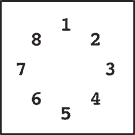 Initial state | 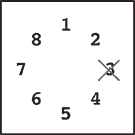 Step 1 | 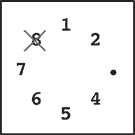 Step 2 | 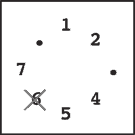 Step 3 | 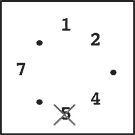 Step 4 |
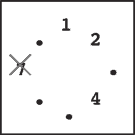 Step 5 | 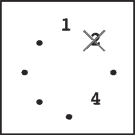 Step 6 | 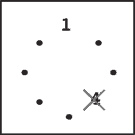 Step 7 | 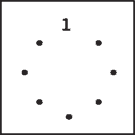 Final state |
Initial state: Eight stones are arranged on a circle.
Step 1: Stone 3 is removed since m = 3.
Step 2: You start from the slot that was occupied by stone 3. You skip four stones 4, 5, 6 and 7 (since k = 5), and remove the next one, which is 8.
Step 3: You skip stones 1, 2, 4 and 5, and thus remove 6. Note that you only count stones that are still on the circle and ignore those already removed. Stone 3 is ignored in this case.
Steps 4–7: You continue until only one stone is left. Notice that in later steps when only a few stones remain, the same stone may be skipped multiple times. For example, stones 1 and 4 are skipped
twice in step 7.
Final State: Finally, only one stone, 1, is on the circle. This is the final state, so the answer is 1.
Input
The input consists of multiple datasets each of which is formatted as follows.
n k m
The last dataset is followed by a line containing three zeros. Numbers in a line are separated by a single space. A dataset satisfies the following conditions.
2 ≤ n ≤ 10000, 1 ≤ k ≤ 10000, 1 ≤ m ≤ n
The number of datasets is less than 100.
Output
For each dataset, output a line containing the stone number left in the final state. No extra characters such as spaces should appear in the output.
Sample Input
8 5 3
100 9999 98
10000 10000 10000
0 0 0
Sample Output
1
93
2019
本程序采用模拟的方式,使用静态链表存储结构,使用数组模拟链表,时间复杂度比较大,代码中要注意使用取遇运算使循环次数大大减少。提交了好几次,总是TLE,加上
%运算后总是出错,那是由于取余运算的结果可能是0,影响正常逻辑,单独考虑这种情况后AC,不过1000+MS,汗.......
下面是我的代码
/**************************************************************************
* Problem: POJ 3517 And Then There Was One
* Copyright 2011 by Yan
* DATE:
* E-Mail: yming0221@gmail.com
************************************************************************/
#include <stdio.h>
int stone[10001];
int main()
{
int i;
int m,n,k;
int tmp;
int cnt;/*用于计数,石头个数*/
int index;
while(1)
{
scanf("%d %d %d",&n,&k,&m);
cnt=n;
m--;/*由于本程序从0开始编号*/
if(n==0) break;
for(i=0; i<n; i++) stone[i]=i+1;
stone[n-1]=0;/*使数组围成环*/
index=m%n;/*保存第m块的位置*/
/*移除第m块石头*/
stone[(m+n-1)%n]=(m+n+1)%n;
cnt--;
while(cnt>0)
{
if(k-1!=cnt)
for(i=0;i<(k-1)%cnt;i++)
{
index=stone[index];
}/*此时指针指向要删除节点的上一个节点*/
else
for(i=0;i<(k-1);i++)
{
index=stone[index];
}/*此时指针指向要删除节点的上一个节点*/
if(cnt==1) printf("%d\n",stone[index]+1);
/*printf("删除%d\n",stone[index]);*/
stone[index]=stone[stone[index]];
cnt--;
}
}
return 0;
}
相关文章推荐
- UVA 1394 And Then There Was One / Gym 101415A And Then There Was One / UVAlive 3882 And Then There Was One / POJ 3517 And Then There Was One / Aizu 1275 And Then There Was One (动态规划,思维题)
- Poj 3517 And Then There Was One(约瑟夫环变形)
- poj 3517 And Then There Was One
- POJ-3517-And Then There Was One
- POJ 3517 And Then There Was One
- POJ 3517 And Then There Was One(约瑟夫环)
- POJ 3517 And Then There Was One 约瑟夫环
- poj 3517 And Then There Was One 约瑟夫问题
- Poj 3517 And Then There Was One Joseph核心问题
- POJ 3517 And Then There Was One(约瑟夫环-递推or模拟)
- POJ 3517 And Then There Was One
- POJ-3517-And Then There Was One
- POJ 3517 And Then There Was One
- 【原】 POJ 3517 And Then There Was One Joseph问题 解题报告
- UVA 1394/POJ 3517 And Then There Was One
- POJ题目3517 And Then There Was One(约瑟夫,公式)
- poj 3517 And Then There Was One(约瑟夫问题)【模板】
- POJ 3517 And Then There Was One (递推,约瑟夫问题变形)
- UVA 1394 POJ 3517 And Then There Was One (双向循环链表和递推)
- POJ 3157 And Then There Was One
